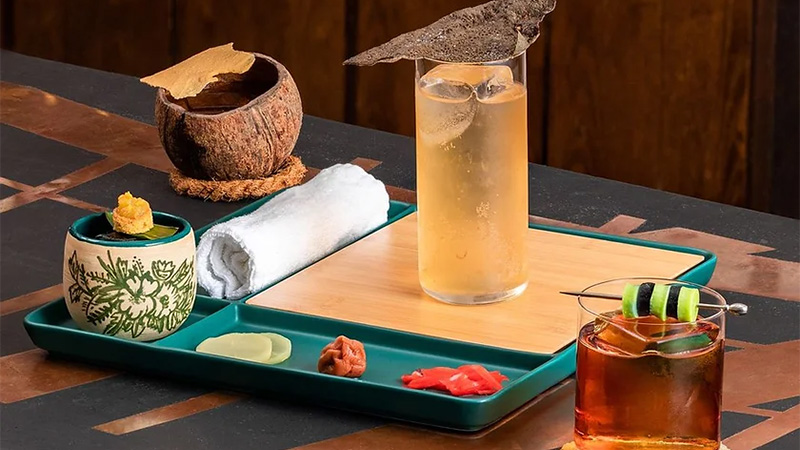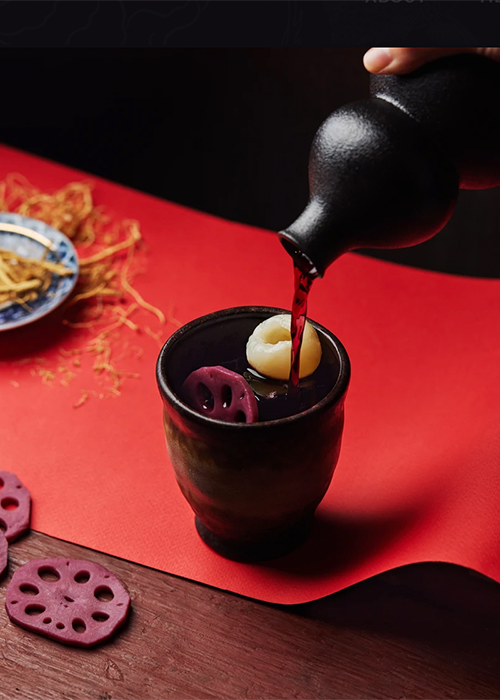As cocktails continue their rise in the United States, in New York, bars and restaurants are putting forth inventive menus with a range of different drink styles. The aim: offering something for everyone. The only catch: When you serve up a liquid smorgasbord, as writer Robert Simonson describes the approach, it becomes increasingly challenging to stand out.
Meanwhile, in Singapore, the drinks capital of Asia, the opposite is true. Cocktails also reign supreme on the island — three of the World’s 50 Best Bars are located in the city — though most bar programs lean into a specific concept; a guiding philosophy rarely diverted from. While this doesn’t mean each bar and restaurant follows a “theme,” the overarching premise of each establishment allows guests to comfortably understand what they can expect, and often makes for a much more cohesive drinking and dining experience.
In Singapore, a Concept Is Crucial
When Singapore’s cocktail scene took off in the late 2000s and early 2010s, spurred on by an influx of expat mixologists, the niche for classic cocktails was quickly filled. The award-winning Jigger & Pony, renowned for its unique and bold takes on modern classics, opened in 2012. Atlas, famous for its Art Deco decorations and 1920s-inspired cocktails to match, debuted just a few years later with the world’s largest collection of gin.
Don’t Miss A Drop
Get the latest in beer, wine, and cocktail culture sent straight to your inbox.
While these spots are successful in their own right — securing the No. 14 and No. 48 spots, respectively, on 2023’s World’s 50 Best Bars list — bar owners in Singapore have come to learn that it takes more than a killer classic cocktail to stand out in the crowd.
“In Singapore, there are a lot of bars that stay strong with the classics, and they’re very good at doing what they’re doing,” says Sebastian Ang, owner of Synthesis, a Singaporean bar and restaurant dishing out food and drink inspired by Traditional Chinese Medicine (TCM). “That’s not how I wanted to position Synthesis. We don’t go near the classics because it doesn’t make us stand out.”
“Our inspirations usually come from the traditions, heritage, culture, and ingredients that grow around us.”
Instead, Ang drew inspiration from his childhood, which was filled with after-school trips to a local TCM clinic with his grandmother. On those excursions, he was exposed to the various herbs and spices used in the medicinal practice as well as their various positive health impacts. When the time came to open Synthesis, his sophomore project, Ang knew he wanted the concept to be geared around wellness, and thought TCM would be perfect for differentiating his food and drink program.
Cocktails at Synthesis account for 80 percent of beverage sales, and the menu features drinks like the Golden Petal, which incorporates chrysanthemum, a bitter herb used in TCM for thousands of years for its cooling properties. Or the Spice Girl’s Whisky, featuring tea-infused whisky alongside ginger and cinnamon, two other core TCM ingredients, and served in a Chinese medicine pot.
Then there are establishments like Native, which landed the No. 42 spot on Asia’s 50 Best Bars of 2023 list (and is ranked 83rd best in the world). As its name suggests, each and every ingredient used in the food and beverage programs is native to Southeast Asia, creating a menu that teems with freshness and showcases the uniqueness of locally sourced ingredients.
“We don’t really base cocktails off classics or twists on classics,” explains Vijay Mudaliar, who co-owns the space. “Our inspirations usually come from the traditions, heritage, culture, and ingredients that grow around us.”

At the three-story bar and restaurant, these native ingredients and inspirations allow for creations like the Strawberry Gochujang and the Kuro Koki — inventive cocktails that incorporate ingredients like yuzu, makgeolli (a Korean sparkling rice wine) purple sweet potato, and kōrēgusu, a Japanese chili sauce. Or the Peranakan, an eponymous cocktail inspired by the people of Singapore that utilizes a jackfruit rum infused with ingredients tied to the culture like pandan, laksa leaves, and coconut sugar.
The core ethos extends beyond the cocktail list: Every spirit on offer at Native was distilled in the region, and each of the house ferments, which account for around 25 percent of beverage sales, are made from Southeast Asian fruits like mango, calamansi, or lychee.

“Singapore is a very global and international city, and I guess that’s [what] most venues here are trying to recreate,” Mudaliar says. “Sometimes in that process, many of our traditions, heritage, and memories are forgotten.”
What makes conceptualized menus so successful, according to Synthesis’ Ang, is that it’s all about Singaporean bars having strong core identities.
“Staying true to our brand identity is very important,” he says. “Of course there are people who aren’t willing to try something new and want to stay with their normal cocktail, like an Old Fashioned, but you came all the way to Synthesis for our unique TCM cocktails. That’s what makes us different, and that’s what we’re going to stick to.”
Whether they’re bars and restaurants serving up classics, TCM-inspired food and drink, or highly specific regional menu items, Singaporean establishments understand what they are and who they serve, and they do it well. The same can’t always be said for the newest NYC cocktail outposts.
The Confusing Rebirth of New York City’s Concept Bars
The increasing trend toward homogenization at New York cocktail bars has seen most establishments offering a signature Martini riff, their own version of the Negroni and the Old Fashioned, and maybe even a sour or two. In many cases, the cocktail program doesn’t align with the food on offer, making it difficult to parse out exactly what any given establishment is really about.
“There’s tequila bars, mezcal bars — but there was no Mexican-American cocktail representation. We’re more than Margaritas, tequilas, and tacos. We can go far beyond that.”
Even when there is a concept — or what appears to be a guiding principle — expectations don’t always match reality. Take Corima, for example, a new restaurant located on Manhattan’s Lower East Side that was “born out of a desire for the northern region of Mexico, specifically the states of Sonora and Chihuahua, to be represented in New York’s culinary landscape.”
Despite that aim, the menu features significant Asian influences, present in cocktails like the Sakura Martini and the Uni Gin Sour, two drinks inspired by Japanese ingredients that sit alongside a collection of Mexican cocktails. The food menu includes a similar fusion of gastronomic styles, with items like potato udon served with corn husk dashi, or cuttlefish dumplings accompanied by tlalpeno broth and squab carnitas.
While these dishes are wonderful and do incorporate the flavors of Sonora and Chihuahua, there’s no mention on the restaurant’s website or menu of the Asian ingredients or techniques that inspired said cocktails or culinary creations.
It’s a similar story at fellow LES restaurant and bar, Jade & Clover, a new Irish-Asian fusion restaurant that opened in December 2023. Aside from the shamrocks decorating the menu and one Irish Coffee-inspired cocktail, blink and you’ll miss what it is that makes this establishment Irish at all.
All You Need Is Direction
In the sea of confusion, there are outliers — bars that have chosen a concept and maintain a steadfast commitment to their core ethos, like Manhattan’s Superbueno, which opened its doors in April 2023. Owner Ignacio “Nacho” Jimenez is exclusively focused on serving Mexican-American cocktails, with a food menu to match.
“When I first thought of opening my own bar, I questioned what I was going to do,” Jimenez says. “There’s tequila bars, mezcal bars — but there was no Mexican-American cocktail representation. We’re more than Margaritas, tequilas, and tacos. We can go far beyond that.”
Nine cocktails round out Superbueno’s menu. There’s a frozen cocktail, a milk punch, a Negroni riff, a version of a Martini, and even a Margarita, but don’t expect them to convey the classics’ flavors.
Instead, each cocktail incorporates an ingredient crucial to Mexican cuisine, like mole, in the case of the Negroni, which is used to fat wash mezcal before it’s fused with Cynar, amaro, sweet vermouth, and xocolati bitters. Or the Green Mango Martini, which draws inspiration from Jimenez’s hometown where finding mango served with lime and chili is as easy as walking to the nearest street corner. Even the Vodka y Soda, a staple in American bars, has a clear connection to Mexico, made with ingredients like guava and pasilla peppers.
The cocktails are recognizable yet entirely unique, fresh yet familiar. But most of all, they’re true to Nacho’s vision of bringing a Mexican-American cocktail bar to life, and they make sense.
In terms of concept and execution, Superbueno feels more in line with what’s trending in Singapore, rather than what’s popular in New York right now. It’s clear, it’s concise, and it’s delicious. And perhaps that’s the key: not necessarily offering something for everyone, but choosing a framework — a guiding philosophy that fills a niche yet to be filled — and executing the program with care, even if it’s a risk.